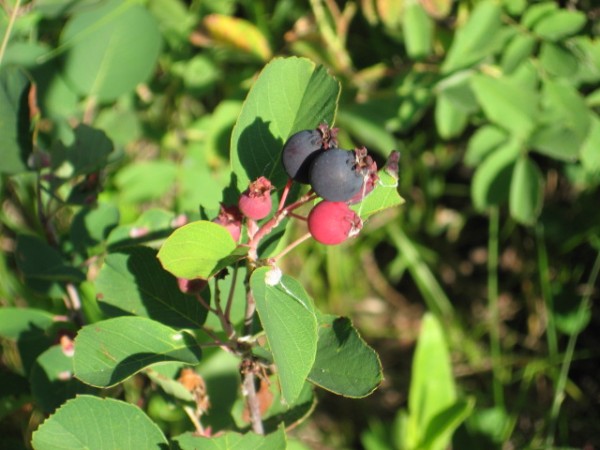When I was little, my Dad used to take us through the river valley and point out the places where houses used to stand, before the valley became a green space and development was curbed. You can tell where houses once stood by looking for rogue apple trees, caraganas and other domestic shrubs. He also taught us how to find hazelnuts before the squirrels got to them and how to collect wild rosehips in the fall.
But it is the saskatoon bushes that I hold closest to my heart. Long ago, when Keillor Road was still a thoroughfare, we used to drive up the hill in our beat up emerald green Ford F150. In the heat of July, my Dad would point out the women with ice cream pails picking the purple-blue berries. They knew where to find the ripest, juiciest ones. My Dad, the grandson of two very tough and hardworking Metis farmers who moved to the city after they retired, said that those women had been picking the berries along Keillor Road for as long as he could remember.
Today, when I ride my bike down the trail where Keillor Road once ran, there are no women picking berries. And I regret that I never got to experience that harvest with them. However, I memorialize and ritualize those women in my own way. During the years I spent walking from home to my job at the University of Alberta, I always found the time to pick saskatoons at my favourite, secret spots throughout the river valley. The places where the slope of the hill caught the most sun, and the right amount of water fell to yield the healthiest, tastiest saskatoons. In June I would buzz with anticipation as I took note of the fragile white blossoms on the saskatoon bushes and would try to memorize where they stood for future collection. And a handful of close friends were shown my favourite berry spots — passing on my little bit of knowledge to others in order to honour the people who harvested and collected food from our landscape for thousands of years.
It is easy, and dangerous, to think that our city was a wild frontier tamed a hundred odd years ago by pioneers. However, if you look closely enough and listen to the stories people share, you will realize its history is much deeper, much richer. And much more complex. It is sometimes tempting to elevate the built form of a place as the only testament to its history and occupation. However, that denies us the possibility of thinking about space and resources in radically different ways. In Edmonton we face the challenge of trying to use our land and resources wisely, and also to understand and respect the people who were here before us. Perhaps we need to develop new tools to address these issues. Just as my Dad taught me about the saskatoons, perhaps we can all take the time to re-imagine our relationship to the landscape around us and consider why people would have chosen to stay here since time immemorial. And then honour that through the ways we build and move through the city. Rather than frame ourselves as a young city — and inhabit the insecurities that come with that — perhaps we need to reconsider our timeline and incorporate the much longer history of our space, as researcher and teacher Dr. Dwayne Donald urges us to do in his work on Edmonton’s ‘origin stories’.
It is then, when we realize this city stretches back through the lives and stories of people who lived here for millennia, that we can truly start to understand how to build and shape ourselves as unique, rooted and fruitful. In the meantime, I’ll be picking berries and remembering those women and their ice cream pails.

